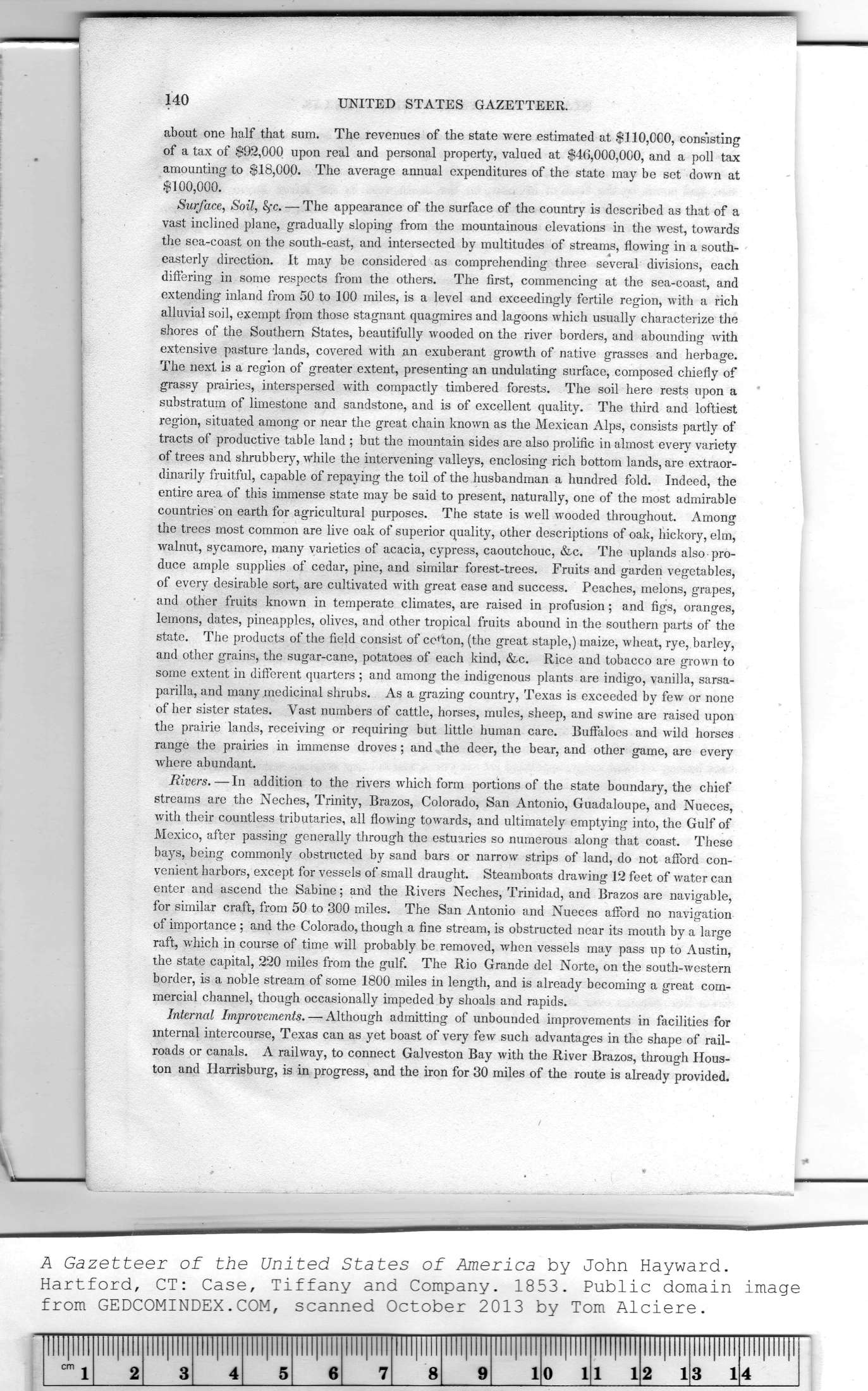|
|
Note: Ctrl and + increases the font size of the text below, Ctrl and - decreases it, and Ctrl and 0 resets it to default size.
140 UNITED STATES GAZETTEER.
about one half that sum. The revenues of the state were estimated at $110,000, consisting
of a tax of $92,000 upon real and personal property, valued at $46,000,000, and a poll tax
amounting to $18,00Q. The average annual expenditures of the state may be set down at
$100,000.
Surface, Soil, fyc. — The appearance of the surface of the country is described as that of a
vast inclined plane, gradually sloping from the mountainous elevations in the west, towards
the sea-coast on the south-east, and intersected by multitudes of streams, flowing in a south-
easterly direction. It may be considered as comprehending three several divisions, each
differing in some respects from the others. The first, commencing at the sea-coast, and
extending inland from 50 to 100 miles, is a level and exceedingly fertile region, with a rich
alluvial soil, exempt from those stagnant quagmires and lagoons which usually characterize the
shores of the Southern States, beautifully wooded on the river borders, and abounding with
extensive pasture lands, covered with an exuberant growth of native grasses and herbage.
The next is a region of greater extent, presenting an undulating surface, composed chiefly of
grassy prairies, interspersed with compactly timbered forests. The soil here rests upon a
substratum of limestone and sandstone, and is of excellent quality. The third and loftiest
region, situated among or near the great chain known as the Mexican Alps, consists partly of
tracts of productive table land ; but the mountain sides are also prolific in almost every variety
of trees and shrubbery, while the intervening valleys, enclosing rich bottom lands, are extraor-
dinarily fruitful, capable of repaying the toil of the husbandman a hundred fold. Indeed, the
entire area of this immense state may be said to present, naturally, one of the most admirable
countries on earth for agricultural purposes. The state is well wooded throughout. Among
the trees most common are live oak of superior quality, other descriptions of oak, hickory, elm,
walnut, sycamore, many varieties of acacia, cypress, caoutchouc, &c. The uplands also ■ pro-
duce ample supplies of cedar, pine, and similar forest-trees. Fruits and garden vegetables,
of every desirable sort, are cultivated with great ease and success. Peaches, melons, grapes,
and other fruits known in temperate climates, are raised in profusion; and figs, oranges,
lemons, dates, pineapples, olives, and other tropical fruits abound in the southern parts of the
state. The products of the field consist of cotton, (the great staple,) maize, wheat, rye, barley,
and other grains, the sugar-cane, potatoes of each kind, &c. Rice and tobacco are grown to
some extent in different quarters ; and among the indigenous plants are indigo, vanilla, sarsa-
parilla, and many medicinal shrubs. As a grazing country, Texas is exceeded by few or none
of her sister states. Vast numbers of cattle, horses, mules, sheep, and swine are raised upon
the prairie lands, receiving or requiring but little human care. Buffaloes and wild horses
range the prairies in immense droves; and the deer, the bear, and other game, are every
where abundant.
Rivers. — In addition to the rivers which form portions of the state boundary, the chief
streams are the Neches, Trinity, Brazos, Colorado, San Antonio, Guadaloupe, and Nueces,
with their countless tributaries, all flowing towards, and ultimately emptying into, the Gulf of
Mexico, after passing generally through the estuaries so numerous along that coast. These
bays, being commonly obstructed by sand bars or narrow strips of land, do not afford con-
venient harbors, except for vessels of small draught. Steamboats drawing 12 feet of water can
enter and ascend the Sabine; and the Rivers Neches, Trinidad, and Brazos are navigable,
for similar craft, from 50 to 300 miles. The San Antonio and Nueces afford no navigation
of importance ; and the Colorado, though a fine stream, is obstructed near its mouth by a large
raft, which in course of time will probably be removed, when vessels may pass up to Austin,
the state capital, 220 miles from the gulf. The Rio Grande del Norte, on the south-western
border, is a noble stream of some 1800 miles in length, and is already becoming a great com-
mercial channel, though occasionally impeded by shoals and rapids.
Internal Improvements. — Although admitting of unbounded improvements in facilities for
internal intercourse, Texas can as yet boast of very few such advantages in the shape of rail-
roads or canals. A railway, to connect Galveston Bay with the River Brazos, through Hous-
ton and Harrisburg, is in progress, and the iron for 30 miles of the route is already provided.
|
Illllllll |
llll|llll |
Illllllll |
Illllllll |
Illllllll |
Illllllll |
Illllllll |
Illllllll |
Illllllll |
Illllllll |
Illllllll |
Illllllll |
Illllllll |
Illllllll |
llll|llll|l |
|
cm j |
2 |
3 |
4 |
5 |
6 |
7 |
8 |
9 |
1 |
0 1 |
1 1 |
2 1 |
3 1 |
4 |
|
